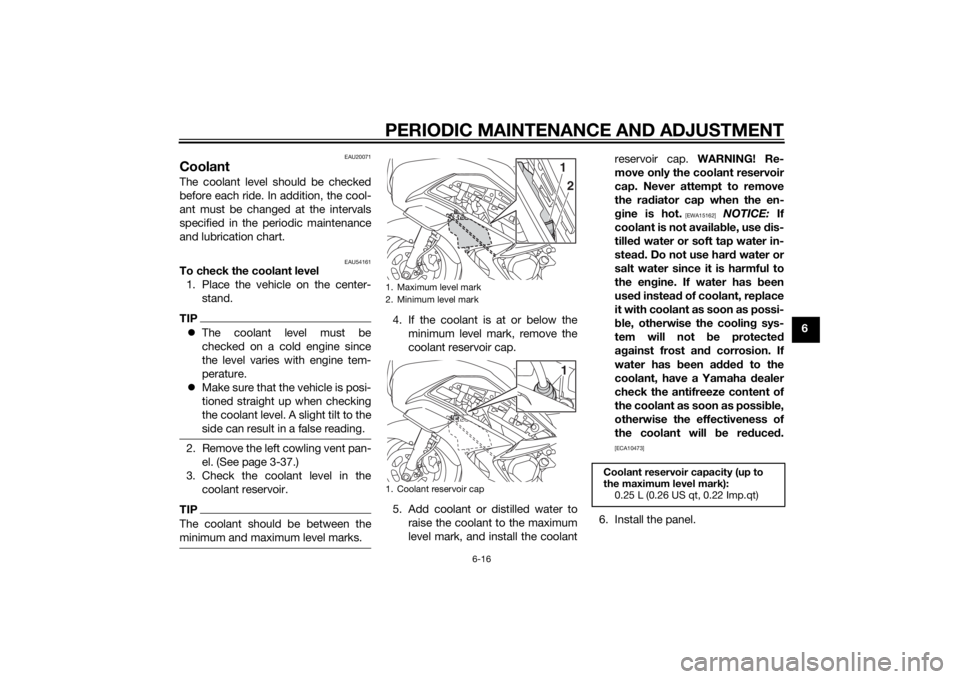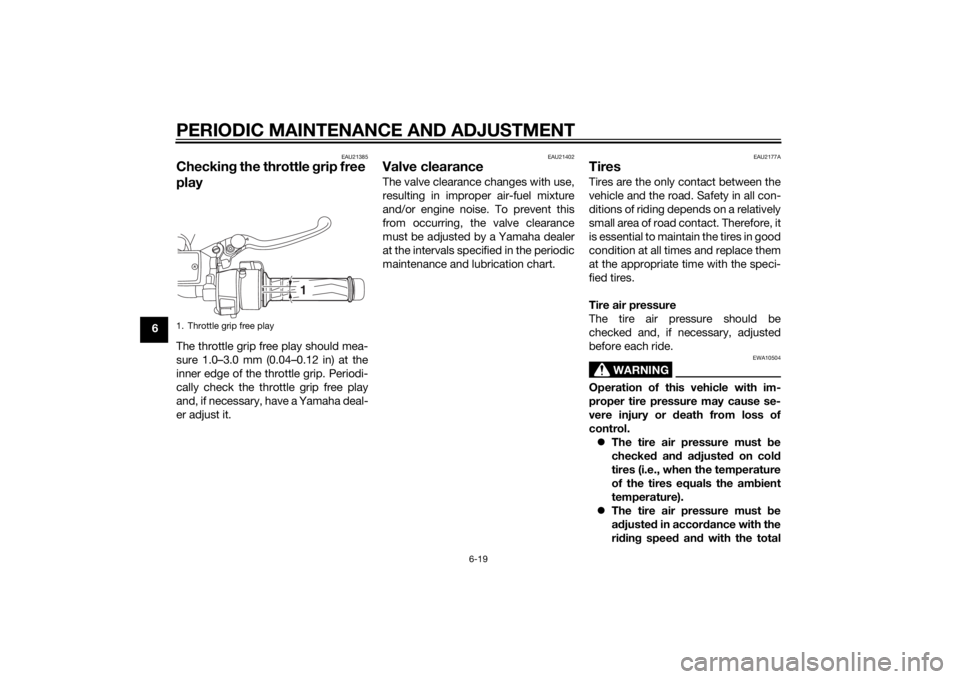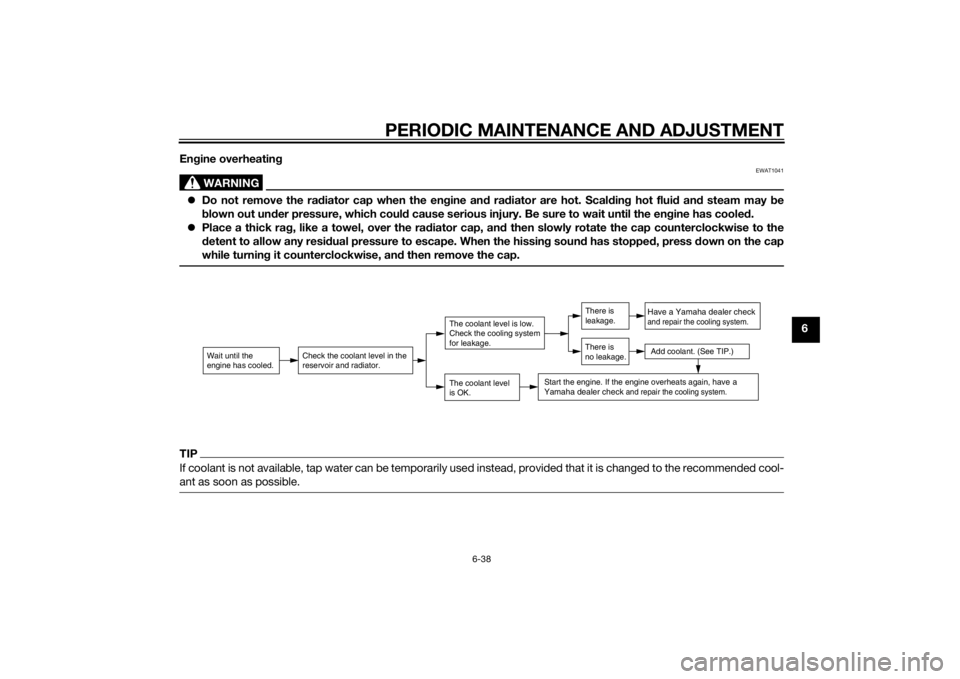check engine YAMAHA FJR1300A 2015 Owner's Manual
[x] Cancel search | Manufacturer: YAMAHA, Model Year: 2015, Model line: FJR1300A, Model: YAMAHA FJR1300A 2015Pages: 120, PDF Size: 3.4 MB
Page 83 of 120

PERIODIC MAINTENANCE AND ADJUSTMENT
6-16
6
EAU20071
CoolantThe coolant level should be checked
before each ride. In addition, the cool-
ant must be changed at the intervals
specified in the periodic maintenance
and lubrication chart.
EAU54161
To check the coolant level1. Place the vehicle on the center- stand.TIPThe coolant level must be
checked on a cold engine since
the level varies with engine tem-
perature.
Make sure that the vehicle is posi-
tioned straight up when checking
the coolant level. A slight tilt to the
side can result in a false reading.2. Remove the left cowling vent pan-
el. (See page 3-37.)
3. Check the coolant level in the coolant reservoir.TIPThe coolant should be between the
minimum and maximum level marks.
4. If the coolant is at or below theminimum level mark, remove the
coolant reservoir cap.
5. Add coolant or distilled water to raise the coolant to the maximum
level mark, and install the coolant reservoir cap.
WARNING! Re-
move only the coolant reservoir
cap. Never attempt to remove
the ra diator cap when the en-
g ine is hot.
[EWA15162]
NOTICE: If
coolant is not availa ble, use dis-
tille d water or soft tap water in-
stead . Do not use har d water or
salt water since it is harmful to
the en gine. If water has b een
use d instea d of coolant, replace
it with coolant as soon as possi-
b le, otherwise the coolin g sys-
tem will not be protected
a g ainst frost and corrosion. If
water has been adde d to the
coolant, have a Yamaha dealer
check the antifreeze content of
the coolant as soon as possi ble,
otherwise the effectiveness of
the coolant will be re duce d.
[ECA10473]
6. Install the panel.
1. Maximum level mark
2. Minimum level mark
1. Coolant reservoir cap
1
21
Coolant reservoir capacity (up to
the maximum level mark): 0.25 L (0.26 US qt, 0.22 Imp.qt)
U1MCE2E0.book Page 16 Monday, June 16, 2014 8:57 AM
Page 85 of 120

PERIODIC MAINTENANCE AND ADJUSTMENT
6-18
6
out with compressed air as
shown. If the air filter element is
damaged, replace it.
6. Insert the air filter element into the air filter case. NOTICE: Make
sure that the air filter element is
properly seate d in the air filter
case. The en gine should never
b e operated without the air filter
element installed , otherwise the
piston(s) an d/or cylin der(s) may
b ecome excessively worn.
[ECA10482]
7. Install the air filter case cover by
installing the screws. NOTICE:
Make sure that the fuel tank
b reather/overflow hose is not
pinche d.
[ECA15412]
8. Install the intake air shroud by in-
stalling the screw and the quick
fastener screws.
9. Install the panel.
EAU44735
Checkin g the en gine i dlin g
spee dCheck the engine idling speed and, if
necessary, have it corrected by a
Yamaha dealer.
1. Fuel tank brea ther/overflow hose
1
Engine i dlin g spee d:
1000–1100 r/min
U1MCE2E0.book Page 18 Monday, June 16, 2014 8:57 AM
Page 86 of 120

PERIODIC MAINTENANCE AND ADJUSTMENT
6-19
6
EAU21385
Checking the throttle grip free
playThe throttle grip free play should mea-
sure 1.0–3.0 mm (0.04–0.12 in) at the
inner edge of the throttle grip. Periodi-
cally check the throttle grip free play
and, if necessary, have a Yamaha deal-
er adjust it.
EAU21402
Valve clearanceThe valve clearance changes with use,
resulting in improper air-fuel mixture
and/or engine noise. To prevent this
from occurring, the valve clearance
must be adjusted by a Yamaha dealer
at the intervals specified in the periodic
maintenance and lubrication chart.
EAU2177A
TiresTires are the only contact between the
vehicle and the road. Safety in all con-
ditions of riding depends on a relatively
small area of road contact. Therefore, it
is essential to maintain the tires in good
condition at all times and replace them
at the appropriate time with the speci-
fied tires.
Tire air pressure
The tire air pressure should be
checked and, if necessary, adjusted
before each ride.
WARNING
EWA10504
Operation of this vehicle with im-
proper tire pressure may cause se-
vere injury or death from loss of
control. The tire air pressure must be
checked and a djuste d on col d
tires (i.e., when the temperature
of the tires equals the amb ient
temperature).
The tire air pressure must be
a d juste d in accor dance with the
ri din g speed and with the total
1. Throttle grip free play
1
U1MCE2E0.book Page 19 Monday, June 16, 2014 8:57 AM
Page 104 of 120

PERIODIC MAINTENANCE AND ADJUSTMENT
6-37
6
EAU42505
Troubleshootin g chartsStartin g pro blems or poor en gine performance
Check the fuel level in
the fuel tank.1. Fuel
There is enough fuel.
There is no fuel.
Check the battery.
Supply fuel.
The engine does not start.
Check the battery.
Remove the spark plugs
and check the electrodes.3. Ignition
Wipe off with a dry cloth and correct the
spark plug gaps, or replace the spark plugs.
Have a Yamaha dealer check the vehicle.
Operate the electric starter.4. Compression
There is compression.
There is no compression.
The engine does not start.
Have a Yamaha dealer check the vehicle.Have a Yamaha dealer check the vehicle.
The engine does not start.
Check the compression.
Operate the electric starter.2. Battery
The engine turns over
quickly.
The engine turns over
slowly.
The engine does not start.
Check the ignition.
The battery is good.Check the battery lead connections,
and have a Yamaha dealer charge
the battery if necessary.
DryWet
Operate the electric starter.
U1MCE2E0.book Page 37 Monday, June 16, 2014 8:57 AM
Page 105 of 120

PERIODIC MAINTENANCE AND ADJUSTMENT
6-38
6
En
gine overheatin g
WARNING
EWAT1041
Do not remove the ra diator cap when the en gine an d ra diator are hot. Scal din g hot flui d an d steam may be
b lown out un der pressure, which coul d cause serious injury. Be sure to wait until the en gine has coole d.
Place a thick rag , like a towel, over the ra diator cap, an d then slowly rotate the cap counterclockwise to the
d etent to allow any resi dual pressure to escape. When the hissin g soun d has stopped , press down on the cap
while turnin g it counterclockwise, an d then remove the cap.TIPIf coolant is not available, tap water can be temporarily used instead, provided that it is changed to the recommended cool-
ant as soon as possible.
Wait until the
engine has cooled.
Check the coolant level in the
reservoir and radiator.
The coolant level
is OK.The coolant level is low.
Check the cooling system
for leakage.
Have a Yamaha dealer checkand repair the cooling system.Add coolant. (See TIP.)
Start the engine. If the engine overheats again,
have a
Yamaha dealer check
and repair the cooling system.
There is
leakage.
There is
no leakage.
U1MCE2E0.book Page 38 Monday, June 16, 2014 8:57 AM
Page 109 of 120

MOTORCYCLE CARE AND STORAGE7-4
7
EAU26244
StorageShort-term
Always store your motorcycle in a cool,
dry place and, if necessary, protect it
against dust with a porous cover. Be
sure the engine and the exhaust sys-
tem are cool before covering the mo-
torcycle.NOTICE
ECA10811
Storin g the motorcycle in a
poorly ventilate d room or cover-
in g it with a tarp, while it is still
wet, will allow water an d humi d-
ity to seep in an d cause rust.
To prevent corrosion, avoi d
d amp cellars, sta bles ( because
of the presence of ammonia)
an d areas where stron g chemi-
cals are stored .Long-term
Before storing your motorcycle for sev-
eral months: 1. Follow all the instructions in the “Care” section of this chapter. 2. Fill up the fuel tank and add fuel
stabilizer (if available) to prevent
the fuel tank from rusting and the
fuel from deteriorating.
3. Perform the following steps to protect the cylinders, piston rings,
etc. from corrosion.a. Remove the spark plug caps and spark plugs.
b. Pour a teaspoonful of engine oil into each spark plug bore.
c. Install the spark plug caps onto the spark plugs, and then
place the spark plugs on the
cylinder head so that the elec-
trodes are grounded. (This will
limit sparking during the next
step.)
d. Turn the engine over several times with the starter. (This will
coat the cylinder walls with oil.)
WARNING! To prevent dam-
a g e or injury from sparkin g,
make sure to groun d the
spark plu g electro des while
turnin g the en gine over.
[EWA10952]
e. Remove the spark plug caps
from the spark plugs, and then
install the spark plugs and the
spark plug caps.
4. Lubricate all control cables and the pivoting points of all levers and
pedals as well as of the side-
stand/centerstand.
5. Check and, if necessary, correct the tire air pressure, and then lift
the motorcycle so that both of its
wheels are off the ground. Alterna-
tively, turn the wheels a little every
month in order to prevent the tires
from becoming degraded in one
spot.
6. Cover the muffler outlets with plastic bags to prevent moisture
from entering them.
7. Remove the battery and fully charge it. Store it in a cool, dry
place and charge it once a month.
Do not store the battery in an ex-
cessively cold or warm place [less
than 0 °C (30 °F) or more than 30
°C (90 °F)]. For more information
on storing the battery, see page
6-30.
U1MCE2E0.book Page 4 Monday, June 16, 2014 8:57 AM
Page 116 of 120

10-1
10
INDEXAABS ....................................................... 3-27
ABS warning light ................................... 3-5
Accessory box ...................................... 3-36
Air filter element, cleaning .................... 6-17
Auxiliary DC jack ................................... 3-45
Auxiliary light......................................... 6-34BBattery .................................................. 6-30
Brake and clutch fluid levels, checking ............................................. 6-24
Brake and clutch fluids, changing ........ 6-25
Brake and clutch levers, checking and lubricating ........................................... 6-27
Brake and shift pedals, checking and
lubricating ........................................... 6-26
Brake lever ............................................ 3-26
Brake lever free play, checking............. 6-22
Brake light switches.............................. 6-23
Brake pedal........................................... 3-26CCables, checking and lubricating ......... 6-26
Care ........................................................ 7-1
Catalytic converters .............................. 3-31
Centerstand and sidestand, checking and lubricating .................................... 6-28
Clutch lever ................................. 3-25, 6-22
Coolant ................................................. 6-16
Cowling vents, opening and closing ..... 3-37
Cruise control indicator lights ................. 3-4
Cruise control switches ........................ 3-24
Cruise control system ............................. 3-6DDimmer/Pass switch ............................. 3-24 D-mode (drive mode) ........................... 3-23
EEngine break-in ...................................... 5-3
Engine idling speed, checking ............. 6-18
Engine oil and oil filter
cartridge ........... 6-12
Engine serial number .............................. 9-1
Engine trouble warning light ................... 3-5FFinal gear oil ......................................... 6-14
Front and rear brake pads, checking ... 6-23
Front fork, adjusting ............................. 3-39
Front fork, checking ............................. 6-29
Front turn signal light............................ 6-34
Fuel ....................................................... 3-30
Fuel consumption, tips for reducing ...... 5-3
Fuel tank breather/overflow hose ......... 3-31
Fuel tank cap ........................................ 3-29
Fuses, replacing ................................... 6-32HHandlebar position, adjusting .............. 3-37
Handlebar switches .............................. 3-23
Hazard switch....................................... 3-24
Headlight beams, adjusting.................. 3-37
Headlight bulb ...................................... 6-33
High beam indicator light ....................... 3-4
Horn switch .......................................... 3-24IIdentification numbers ............................ 9-1
Ignition circuit cut-off system ............... 3-43
Immobilizer system ................................ 3-1
Immobilizer system indicator light .......... 3-6
Indicator lights and warning lights ......... 3-4LLicense plate light bulb, replacing........ 6-35
MMain switch/steering lock .......................3-2
Maintenance and lubrication, periodic....6-4
Maintenance, emission control
system ..................................................6-3
Matte color, caution ................................7-1
Menu switch..........................................3-24
Model label .............................................9-1
Multi-function meter unit .......................3-10NNeutral indicator light ..............................3-4OOil level warning light ..............................3-4PPanels, removing and installing ..............6-8
Parking ....................................................5-4
Part locations ..........................................2-1RRear suspension, lubricating ................6-28
Rear view mirrors ..................................3-39
Rider seat height, adjusting ..................3-33SSafety information ...................................1-1
Seats .....................................................3-32
Select switch.........................................3-25
Shifting ....................................................5-2
Shift pedal .............................................3-26
Shock absorber assembly, adjusting ....3-41
Sidestand ..............................................3-42
Spark plugs, checking ..........................6-11
Specifications .........................................8-1
Start/Engine stop switch .......................3-24
Starting the engine ..................................5-1
Steering, checking ................................6-30
U1MCE2E0.book Page 1 Monday, June 16, 2014 8:57 AM